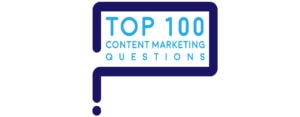
“How can a content site with a main focus on traditional articles and infographics drive social media type engagement and extract customers’ questions, comments, etc.? Is there a tactic (pop-up, etc.) that doesn’t frustrate users?”
How to Drive Engagement
This question comes from a marketer at New York Life. It ranks among the Top 100 Questions on content marketing.
If intrusive tactics like pop-ups don’t fit users’ needs or the spirit of your brand, use other approaches to get people more engaged with your content. Here are 4 ideas: tap into people’s curiosity, make it easier to engage, make it more personal, and reward sharing.
1. Tap into people’s curiosity
Human curiosity is insatiable. To take advantage of human tendencies, pique our curiosity.
One great way to do that: write a headline that asks a question with the word “you” in it.
Online, people are 175% likelier to click on question headlines with the word “you” than on declarative statement headlines, found a study by researchers at the BI Norwegian Business School.
Ask intriguing questions that make people ponder the answer, rather than simple yes/no questions. For example, your brand can create daily or weekly 1-question quizzes.
Pose a single question that makes people take sides. For example, my smartphone is A. Apple B. Google C. other.
Show people how many others gave each answer, so they see the group they fit into.
Now that you’ve hooked their interest and opened up the topic of smartphones, follow up with closely related information people want to know. For example, right now smartphone users are asking questions about 5G:
- What jobs does it do better than 4G?
- How will 5G affect consumers?
- How will 5G affect businesses?
- When will it become locally available?
Smart cellular providers are gathering these questions, analyzing which are most important, and answering the top questions visibly on their websites. Here’s how to harness customer questions to create content.
Of course, you can move beyond one question to short surveys and quizzes that let people test their knowledge or get context for their viewpoint.
Offer a quiz or assessment, with a custom-generated answer for each user. Give people a sense of how long the quiz is going to take beforehand (1 minute? 5 minutes? 20 minutes?)
Then, provide customized feedback to participants that reflects their input and recommends the next steps.
2. Make it easier to engage
Human brains only weigh 3 pounds, yet they consume 20% to 25% of your energy and oxygen.

Thinking is taxing! That’s why many people coast through most of the day on autopilot, minimizing the number of decisions they’ll need to make.
For example, it’s easier for people to see and respond to visuals than to text. Visuals generally spread more on social media. A webdam.com study found that posts including images produced 650% more engagement than text-only posts.
Make it easy for readers to share content without thinking about it too much. For example, add a “share with a colleague” button on content webpages and in email newsletters.
“Share with a colleague” enables you to build an interested audience that’s been prequalified by other audience members.
Tools that help you produce share-worthy images include:
- Canva, BeFunky, PicMonkey, and Placeit to create images.
- CloudApp, LICEcap, and RecordIT to create GIFs.
- QuotesCover to create images from quotes.
- Pixlr Express to crop, color, and edit images.
- Venngage to create infographics.
Make sure that your images do the job of delivering a relevant message to your audience.
Write a caption for every image. Why?
Because about 9 out of 10 people read the first caption on a webpage. After images, people engage most with headlines, subheads, and captions.
3. Make content even more personal to drive engagement
Imagine the New York Times with your name on the front page. Of course you want a copy!
People see lots of content every day, but they pay the most attention when they hear or see their name – or other signs of personalization.
Personalization goes way beyond the salutation “Dear George,” although that’s a good place to start.
When you name customers and employees in your content, you make content inherently more personal. People want to hear what you said about them.
Some brands enable you to take or make personalized photos of yourself with the brand. For example, The Home Depot lets you put yourself on the cover of its magazine with a selfie.

Before the pandemic, The Wall Street Journal drew crowds who wanted their portrait in the Journal’s unique format called a “hedcut.” Yeah, I stood in line at Content Marketing World to get one of my own.

Back then, even Mickey Mouse would pose with me for a photo.

Right now COVID-19 is creating pent-up demand for personalized brand interactions like these, involving real people and cartoon characters. Once the pandemic recedes, people will expect an even better quality of experience at your events.
Personalized content such as this will always be treasured by the customer who’s in the picture with your brand. How can you make it easy for customers to personalize their image with your brand?
4. Reward people’s sharing behaviors to drive engagement
Who shared the most content for your brand organically last week? Last month? Last year?
How can you make them famous for a moment? Celebrate the people who share lots of your content. Publicize who shared your content and reward them for their work.
Gaming computer maker MSI confers points and ranks to gamers who create and share content. The user-generated content that MSI rewards include unboxing videos, text reviews, and video reviews.
A business-to-business brand that focuses successfully on personalization is Mathematica, which applies artificial intelligence (AI) to solve healthcare problems.
Perhaps the most successful brand in user-created content is Lego. Lego users generate 20 times more content than its marketers do.
One reason Lego is so popular is that users can design and propose new Lego sets through Lego Ideas. When designers of new sets are successful, they even get their picture on the Lego set they invented! That’s the ultimate in content personalization.
Drive engagement with your content by tapping into people’s curiosity, making it easy to engage, making it even more personal, and reward sharing.
“How can a content site with a main focus on traditional articles and infographics drive social media type engagement and extract customers’ questions, comments, etc.? Is there a tactic (pop-up, etc.) that doesn’t frustrate users?” is one of the Top 100 Questions on content marketing.





